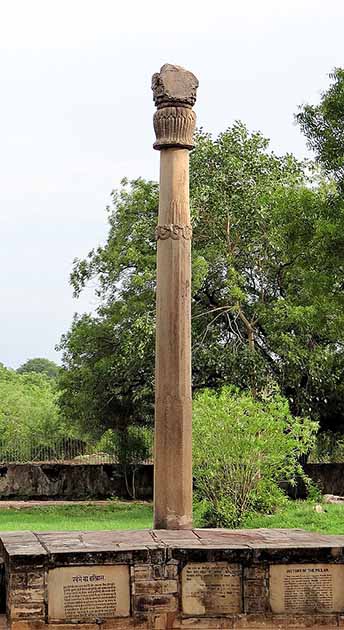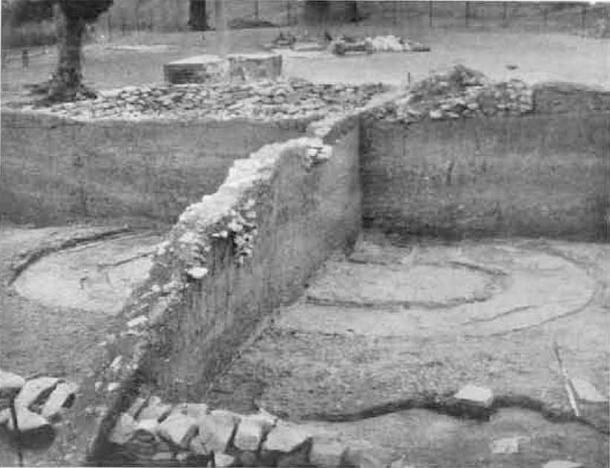
The Heliodorus Pillar: Proof of Greek Worshippers In 200 BC Hindu India?
Sometimes archaeological discoveries are made that don’t make much sense or seem out of place. Often these mysteries are solved and have simple explanations. Take for example the Heliodorus pillar in central India. A pillar with an inscription to the Hindu gods but bearing the name of an ancient Greek diplomat. Seemingly mundane at first glance the discovery of Greek names carved on the pillar in a timeless South Asian script caused much excitement upon their discovery. So why are there Greek names on an ancient Hindu pillar and what does it tell us?
The Discovery of the Heliodorus Pillar in 1877
The Heliodorus pillar was discovered in 1877 by a British engineer and archaeologist called Alexander Cunningham. It was found close to the ancient city of Besnagar at the confluence of the Betwa and Halalia rivers.
The pillar, as it stood then, was coated with a red paste to such an extent that many of its features had been obscured. People had been using the pillar as an object of worship and animal sacrifice, apparently applying red paste to the pillar as part of this worship. The locals called the pillar Khamba Baba or Kham Baba.
- Lakshmi: The Enigmatic Hindu Personification Of Mother Nature
- Greek Buddhism, The Forgotten Chapter In A Philosophy That Began in India
Despite the seeming lack of inscriptions on the pillar, Cunningham's instincts told him he had stumbled across something special. The shape and features that were visible through the paste (like the crowning emblem) told him the pillar was of some historical significance.
Cunningham described the pillar as, “the most curious and novel” of his discoveries. His interest only increased upon finding two more pillars within a one kilometer (0.62-mile) radius which appeared to be connected somehow to his original find.

The "full" Heliodorus pillar in Vidisha, India as it looks today. Now we know it is just a fragment of a huge piece of early Greek-Indian history. (Dilipkumarftii1977 / CC BY-SA 4.0)
From Red-Paste Layers to Greek Name In Ancient Brahmi Script
Nothing much else happened with the pillar for another 30 years. Then between 1909-1910, a new team led by H. H. Lake returned to the site. They quickly got to work scraping away the red paste and found Brahmi (an ancient south Asian script) inscriptions underneath.
The inscriptions were reported and to everyone's astonishment, it was found that the longer of the two inscriptions related to an ancient Greek called Heliodorus, a Greek ambassador from the 2nd century BC, and the deity Vasudeva. The smaller inscription was a list of human virtues that was later found to be from the Mahabharata (one of two major Sanskrit epics from ancient India).
These inscriptions were peculiar enough to merit two larger excavations. The first took place between 1913 and 1915 but was never completed. A local priest had built his home on a mound next to the pillar and blocked the process of the excavation, stating it was his home. Despite the priest's interruptions, it was found that the site had flooded repeatedly over the last 2000 years leaving a heavy layer of silt. A large rectangular substructure was also discovered as well as more ruined parts. This indicated that the pillar was actually part of a much larger ancient site.

The outlines of an elliptical temple were found deep beneath the mound the local priest’s house was on, next to the Heliodorus pillar. (Ministry of Culture / GODL-India)
A fourth survey occurred from 1963-1965 and its findings were much more substantial. By this time the priest had been evicted and his home demolished. The mound below his home was found to contain the brick foundation for the sanctum and pillared halls of an elliptical temple.
Below this foundation was discovered yet another foundation of an even more ancient temple. The archaeologists decided to dig even deeper and found that the pillar itself went much deeper than originally thought.
As the area had flooded repeatedly, secondary foundations had been added to match the rising ground level caused by the floods’ silt deposits. It was found that as Cunningham had expected nearly 100 years before, the pillar was part of a set. There were 8 pillars in total, aligned along the North-South axis. When all the discoveries from the four excavations were put together it could be safely concluded that the Heliodorus Pillar was part of a much larger ancient temple.
Images of the deities that were likely those worshipped in the very shrines the Greek diplomat Heliodorus visited or worshipped at. This coinage of Agathocles of Bactria (190-180 BC) shows the Indian deities of Saṃkarṣaṇa and Vāsudeva with their attributes. (Classical Numismatic Group, Inc. http://www.cngcoins.com / CC BY-SA 2.5)
Why the Heliodorus Pillar is Special
One of the reasons the inscriptions on the pillar are so significant is because they are evidence that Heliodorus was one of the first recorded Westerners to convert to Vaishnavism (a major Hindu denomination).
Not everyone is convinced however that the inscription means Heliodorus converted. The inscription is a dedication by Heliodorus stating that Vasudeva is the supreme deity. This might just be a diplomatic gesture. A way to show respect to the locals and their beliefs which is a major part of a diplomat like Heliodorus’ job.
Or it could be part of typical Greek religious practice. It was a normal Greek practice to make dedications to foreign gods when visiting foreign lands. The Greeks were happy to appropriate new gods and their powers. It could be that rather than leaving his Greek religion and adopting Hinduism, Heliodorus was just adding a new god to his own personal pantheon.
Whilst the appearance of Heliodorus’ name has caused the most excitement regarding the pillar, it isn’t the pillar's greatest contribution to history and archaeology. The fact that the pillar can be dated precisely to the reign of Antialkidas (115-80BC), means it can be used as a marker for the evolution of Indian art.
The design and motifs on the pillar can be used to date the architectural elements of the nearby Buddhist complex of Sanchi. Having the pillar as a fixed reference point in time allows archaeologists to decide if other sites predate it, come later, or date from around the same time.
The pillar is also helpful in tracking the nature of the evolution of Vasudeva (later called Krishna) in the Hindu religion. It is believed that Vasudeva may have originally been a real historical figure who later became deified. We know from coinage that by 190-180 BC that by this time he was already considered a deity. On the Heliodorus pillar, he receives another promotion, being referred to as the supreme deity. He would keep evolving over the next few centuries until resembling modern Hinduism with its depiction of Vishnu and his four emanations.
Conclusion
The Heliodorus pillar is a great example of how important a seemingly innocuous archaeological find can be. When Cunningham discovered the pillar in 1877 his gut instinct was that he’d found something special, even though all he’d found was an old pillar covered in red paste.
- Worshipped by Millions: The Sacred River Ganges
- Of Kin and Kind: The Role of Myths in Ancient Greek Diplomacy
He was right but it would take nearly a hundred years to prove just how right he was. The fact the pillar was built by an Ancient Greek and hints at his conversion to early Hinduism challenges the picture of Ancient Greeks we normally have in our heads.
Furthermore, the Heliodorus pillar has been instrumental in dating other nearby religious sites and tracing the evolution of Indian art during the Sunga period (185-73BC). It is also useful in helping to track the evolution of early Hindu beliefs and Vasudeva’s status as a god. Not bad for an old pillar covered in a red paste.
Top image: The structure and decorative elements of the Heliodorus pillar which links ancient India to Greece and serves as a precise time marker. The pillar originally supported a statue of Garuda, now lost, or possibly located in the Gujari Mahal Museum in Gwalior. Source: Public domain
By Robbie Mitchell
References
Hebner. J. & Rosen. S. 2014. T he Heliodorus Column. Available at: https://www.archaeologyonline.net/artifacts/heliodorus-column
Irwin. J. 1974. The Heliodorus Pillar at Besnagar: A Fresh Appraisal. Available at: https://archive.org/details/aarp-the-heliodorus-pillar-a-fresh-appraisal/page/n1/mode/1up
Sinha. S. 2018. How the Historic Pillar of Heliodorus Became Khamba Baba. Available at: https://thewire.in/history/how-the-historic-pillar-of-heliodorus-became-khamba-baba
Wallace. S. 2016. Greek Culture in Afghanistan and India: Old Evidence and New Discoveries. Available at: https://www.academia.edu/25638818
















Comments
Many very old relics, such as the Sphinx and the Giant Buddha of Leshan were refaced in the post Ice Age era. Then, of course, there are the smashed noses of nearly all ancient Greek marble statues. There is obviously a clear pattern of disrespect for the work and subject of the original masons and sculptors, who were likely the Atlantean era (pre Ice Age) ancient Greeks, ...who’ve been buried twice, proverbially speaking. If they laid mud bricks overtop the ruins of megalith stone temples, of course they would carve their own inscriptions on the earlier work.
Nobody gets paid to tell the truth.